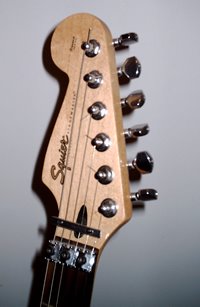 This is a series of photos of the Stagemaster guitar that is the subject of this blog. I believe I bought it in 2000 sometime, and according to my research, it was also built in 2000. I have not pulled the neck off to see if there is a date stamp, which is where you can find the date on Fender guitars (or at least Strats).
This is a series of photos of the Stagemaster guitar that is the subject of this blog. I believe I bought it in 2000 sometime, and according to my research, it was also built in 2000. I have not pulled the neck off to see if there is a date stamp, which is where you can find the date on Fender guitars (or at least Strats).This model was built in a host of different countries including Japan, Korea, China and also Indonesia that I know of. My particular Stagemaster was "Crafted in China" as stated by the stamp on the back of the headstock.
A few features to note are the reverse headstock, the HSH pickup configuration, the Floyd Rose tremolo system, the locking nut, and one tone control (which I am considering reconfiguring).
 The body is solid alder and the neck and headstock are maple with a non-gloss finish. The fretboard is rosewood and there are 22 frets. Relatively speaking, this is a fairly heavy guitar (heavier than my old Strat was), and is very solidly constructed. Because of the substantial weight and nice balance, it is a great guitar to play while standing. The high gloss black paint job is flawless. I know how to paint and I know a good paint job when I see one, and this is a good one. I have heard similar comments regarding the paint from other people who own this model of Stagemaster. Somehow, the quality control of the paint seems consistent from country to country.
The body is solid alder and the neck and headstock are maple with a non-gloss finish. The fretboard is rosewood and there are 22 frets. Relatively speaking, this is a fairly heavy guitar (heavier than my old Strat was), and is very solidly constructed. Because of the substantial weight and nice balance, it is a great guitar to play while standing. The high gloss black paint job is flawless. I know how to paint and I know a good paint job when I see one, and this is a good one. I have heard similar comments regarding the paint from other people who own this model of Stagemaster. Somehow, the quality control of the paint seems consistent from country to country.The Floyd Rose tremolo is a great feature, but it took some getting used to. Stringing one for the first time was an unexpected challenge. This guitar once tuned, stays in tune because of the locking nut, which is another first for me. The tremolo and bridge are chromed and appear to very nicely done. I have read that this model also came with flat black hardware which tended to rust.
 As I said in the introductory entry, the action is fantastic and is one of the main reasons I decided to hot rod this guitar. I actually like the way it plays better than my Strat, Les Paul, or Washburn played. I could swear that the reverse headstock gives the strings a different, kind of "wanky" tension that really facilitates faster and easier playing. I have discussed my "reverse headstock string tension theory" with several other guitar players and have yet to get any of them to agree with me. This whole thing, of course, could be my imagination, who knows; however, the overall playability of this guitar suits me very well. I like it a lot.
As I said in the introductory entry, the action is fantastic and is one of the main reasons I decided to hot rod this guitar. I actually like the way it plays better than my Strat, Les Paul, or Washburn played. I could swear that the reverse headstock gives the strings a different, kind of "wanky" tension that really facilitates faster and easier playing. I have discussed my "reverse headstock string tension theory" with several other guitar players and have yet to get any of them to agree with me. This whole thing, of course, could be my imagination, who knows; however, the overall playability of this guitar suits me very well. I like it a lot.The problem, unfortunately, is the junky electronics which you can't see in the photos. You would really have to hear it to understand it. Also, quite unbelievably, the pickup at the bridge is not even an f-spaced pickup. Specifically, it is a standard pickup placed in the bridge position. Because guitar strings naturally grow farther apart from each other the closer they get to the bridge, a special, f-spaced pickup at the bridge is called for. This will allow the pole pieces on the pickup to properly line up under the strings. I will take some close-up photos of current bridge pickup where you can see just how far off this thing is. The new pickups I have ordered for this guitar include a proper f-spaced pickup for the bridge position.
This pretty much sums up the guitar in question. I will detail the new pickups in the next entry and will also explain why, after owning several classic guitars, I ended up with guitar made in China.
Crispy

No comments:
Post a Comment